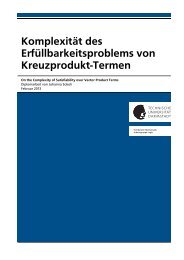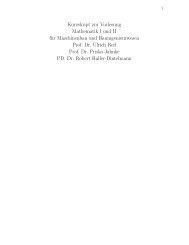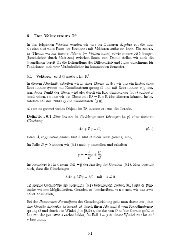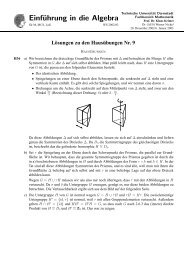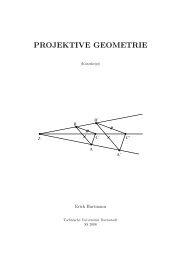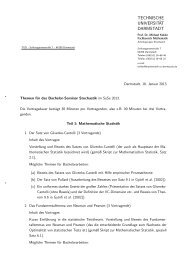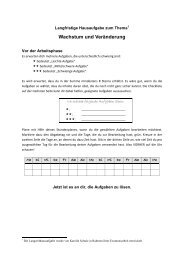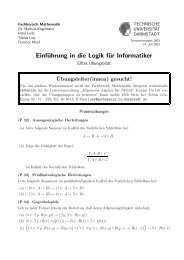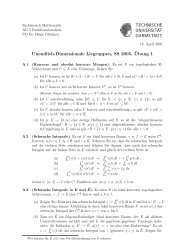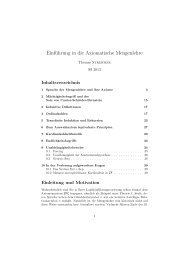DONLP2 USERS GUIDE
DONLP2 USERS GUIDE
DONLP2 USERS GUIDE
You also want an ePaper? Increase the reach of your titles
YUMPU automatically turns print PDFs into web optimized ePapers that Google loves.
1 Copyright<br />
<strong>DONLP2</strong> <strong>USERS</strong> <strong>GUIDE</strong><br />
P. SPELLUCCI<br />
Technical University at Darmstadt, Department of Mathematics<br />
64289 Darmstadt, Germany<br />
email: spellucci@mathematik.tu-darmstadt.de<br />
This information is copyright by Prof. Dr. Peter Spellucci from the mathematics department of the<br />
Technical University at Darmstadt.<br />
2 GENERAL DESCRIPTION<br />
Purpose:<br />
Minimization of an (in general nonlinear) differentiable real function f subject to (in general nonlinear)<br />
inequality and equality constraints g, h.<br />
f(x) = min<br />
x∈S<br />
S = {x ∈ IR n : h(x) = 0, g(x) ≥ 0} .<br />
Here g and h are vectorvalued functions of dimension NG and NH.<br />
Bound constraints are integrated in the inequality constraints g. These might be identified by a special<br />
indicator (see GUNIT below) in order to simplify calculation of its gradients and also in order to allow a<br />
special treatment, known as the gradient projection technique. Also fixed variables might be introduced<br />
via h in the same manner.<br />
2.1 Method employed<br />
The method implemented is a sequential equality constrained quadratic programming method (with an<br />
active set technique) with an alternative usage of a fully regularized mixed constrained subproblem in<br />
case of nonregular constraints (i.e. linear dependent gradients in the ”working set”). It uses a slightly<br />
modified version of the Pantoja-Mayne update for the Hessian of the Lagrangian, variable dual scaling<br />
and an improved Armijo-type stepsize algorithm. Bounds on the variables are treated in a gradientprojection<br />
like fashion. Details may be found in the following two papers :<br />
P. Spellucci: An SQP method for general nonlinear programs using only equality constrained subproblems.<br />
Math. Prog. 82, (1998), 413–448<br />
P. Spellucci: A new technique for inconsistent problems in the SQP method. Math. Meth. of Oper. Res.<br />
47, (1998), 355–400. (published by Physica Verlag, Heidelberg, Germany).<br />
2.2 System requirements<br />
The software is written in ANSI-F77 with MILSTD 1753 extensions with the exception of two routines<br />
O8CPU() for giving the processes cpu-time and O8TIDA() for writing the run’s date and starting time,<br />
1
which in the present implementation use the unix-system-call gettimeofday and times. These usually can<br />
be found in the C-library (include gettimeofday.c in compiling if not automatic for your FORTRAN-callscript)<br />
The user should replace (or remove) these calls for other systems. The corresponding routines are<br />
to be found in the file sysdepen.f. The user may replace this by dummy.f from the distribution in the<br />
simplest case.<br />
2.3 RESTRICTIONS<br />
Since the algorithm makes no use of sparse matrix techniques, its proper use will be limited to small and<br />
medium sized problems with dimensions up to 300 (for the number of unknowns) say. The number of inequality<br />
constraints however may be much larger. (E.g. the code did solve the Ecker-Kupferschmid-Marin<br />
”robot-design” examples in SIJSC 15, 1994, with n=51 unknowns and m=3618 inequalities successfully<br />
within 400-900 sec’s depending on the variation of the problem on an HP9000/735). The maximal allowed<br />
dimensions are set in the file O8PARA.INC. The distribution comes with NX=300, NRESM=300.<br />
2.4 SYSTEM DEPENDENCIES<br />
The code has been successfully tested on the HP9000/7xy , SGI , SUN and DEC ALPHA, INTEL PEN-<br />
TIUM (under LINUX) systems but should run on any UNIX-V system without any changes. It has been<br />
designed such that changes for other systems are quite simple.<br />
In order to change the maximal possible dimensions, reedit the PARAMETER (NX=.....) line of O8PARA.INC<br />
and recompile the code.<br />
In order to use the code on CRAY-like systems, reedit donlp2.f, and the include-files (files ending with<br />
*.INC) changing globally DOUBLE PRECISION to REAL and the double precision constants which are assembled<br />
in the PARAMETER-statement of O8CONS.INC to real format.<br />
3 USAGE<br />
<strong>DONLP2</strong> is written as a selfcontained system of subprograms. The user issues a<br />
call donlp2<br />
supplying necessary information in a series of userwritten subprograms and in some common areas described<br />
below. A rudimentary main-program donlp2main.f is contained in the distribution of the code.<br />
3.1 PROBLEM DESCRIPTION<br />
The user has to define the problem through function evaluation routines. This may be done in two ways:<br />
Method one gives any function and gradient evaluation code individually. In this case the parameter<br />
BLOC has to be set to FALSE. This is the default.<br />
1 EF(X,FX) returns FX=f(x) given x as input. Arguments DOUBLE PRECISION X(*),FX<br />
2 EGRADF(X,GRADF) returns GRADF=∇f(x) given x as input.<br />
Arguments DOUBLE PRECISION X(*),GRADF(*).<br />
3 EH(I,X,HXI) returns the value of the i-th equality constraint as hxi given i and x as input. Arguments<br />
INTEGER I; DOUBLE PRECISION X(*),HXI.<br />
4 EGRADH(I,X,GRADHI) returns ∇hi(x) as GRADHI given i and x as input. Arguments INTEGER I ;<br />
DOUBLE PRECISION X(*),GRADHI(*).<br />
2
5 EG(I,X,GXI) returns gi(x) as GXI given i and x as input. Arguments INTEGER I; DOUBLE PRECISION<br />
X(*),GXI. Bound constraints have to be programmed here too. The evaluation of their gradients<br />
however may be much simplified. See below concerning the usage of GUNIT.<br />
6 EGRADG(I,X,GRADGI) returns ∇gi(x) as GRADGI given i and x as input. Arguments INTEGER I ;<br />
DOUBLE PRECISION X(*),GRADGI(*). For bound constraints, no evaluations must be coded here if<br />
GUNIT is initialized properly.<br />
7 SETUP0 has to set some problem specific data in <strong>DONLP2</strong>’s common areas as described below. SETUP0<br />
is the first subprogram called by <strong>DONLP2</strong> prior to any other computation.<br />
8 SETUP may set user specific data (not transparent to <strong>DONLP2</strong>) as well as parameters of <strong>DONLP2</strong> e.g.<br />
in order to supersede <strong>DONLP2</strong>’s standard parameter setting.<br />
!!! SETUP is called after SETUP0 and after <strong>DONLP2</strong>’s standard initialization, which is done in O8ST.<br />
SETUP must not change data set already in SETUP0, especially not<br />
N,NH,NG,XSC,GUNIT,DEL0,TAU0,ANALYT,DIFFTYPE,EPSFCN,TAUBND<br />
9 SOLCHK may add additional final computations, graphical output using e.g. information from ACCINF<br />
(see below) and so on. This distribution contains a solchk.f with an empty body.<br />
donlp2usrfc.f in this directory contains a rudimentary version of these routines which easily may be<br />
completed by the user. The bodies of SETUP, EG, EGRADG, EH, EGRADG and SOLCHK may be empty of<br />
course. In that case unconstrained minimization using the BFGS-method is done. The correctness of<br />
EGRADF, EGRADH and EGRADG can to some extent be checked by running testgrad.f (in this directory) with<br />
the set of user routines .<br />
Alternatively the user might prefer or may be forced to evaluate the problem functions by a black-box<br />
external routine. In this case he has to set<br />
BLOC=.TRUE.<br />
within SETUP0 and to use a subroutine<br />
EVAL EXTERN(MODE)<br />
This routine has to take XTR, which is a copy of X, from the O8FUEXTR common area as input and to<br />
compute , according to the setting of MODE and ANALYT either FU(0:NH+NG) or both FU(0:NH+NG) and<br />
FUGRAD(I,0:NH+NG), I=1,N and then return to the user. The meaning of MODE is as follows:<br />
1 MODE=0 compute only those constraints which depend linearly on exactly one variable, i.e. fixed<br />
variables conditions and bound constraints. These constraints are identified by GUNIT(1,I)=1.<br />
2 MODE=1 compute only FU, i.e. function values.<br />
3 MODE=3 compute function and gradient values FU and FUGRAD.<br />
The routines SETUP0, SETUP and SOLCHK must be present in this case too, SETUP and SOLCHK may have<br />
an empty body of course.<br />
<strong>DONLP2</strong> has a built-in feature for doing gradients numerically. This can be used for both methods of<br />
problem description. This is controlled by the variables ANALYT , EPSFCN, TAUBND and DIFFTYPE. If<br />
ANALYT=.TRUE. then <strong>DONLP2</strong> uses the values from the EGRAD.. routines or from FUGRAD, according to<br />
the setting of BLOC. If ANALYT=.FALSE., then numerical differentiation is done internally using a method<br />
depending on DIFFTYPE.<br />
1 DIFFTYPE=1 Use the ordinary forward difference quotient with discretization stepsize 0.1EPSFCN 1/2<br />
componentwise relative.<br />
2 DIFFTYPE=2 Use the symmetric difference quotient with discretization stepsize 0.1EPSFCN 1/3 componentwise<br />
relative.<br />
3
Here<br />
3 DIFFTYPE=3 Use a sixth order approximation computing a Richardson extrapolation of three symmetric<br />
difference quotient values. This uses a discretization stepsize 0.01EPSFCN 1/7 .<br />
EPSFCN<br />
is the expected relative precision of the function evaluation. The precision obtained in the gradients is<br />
then of the order of EPSFCN 1/2 , EPSFCN 2/3 , EPSFCN 6/7 respectively. Since numerical differentiation can<br />
also occur if variables are on their bounds, the user must supply a further parameter<br />
TAUBND<br />
which gives a positive value by which any bound present may be violated. This is an absolute value such<br />
that each bound can be violated by as much as TAUBND. TAUBND must be larger than zero of course. The<br />
user is warned that numerical differentiation uses n, 2n, 6n additional function evaluations for a single<br />
gradient for DIFFTYPE=1,2,3 respectively.<br />
The sequence of routines described above has to be present in any case. (If EVAL EXTERN is used, then of<br />
course the bodies of EF, EGRADF, EH, EGRADH, EG, EGRADG are to be empty. This distribution contains<br />
such a file donlp2dummyfu.f .) Bound constraints are treated in a special way by <strong>DONLP2</strong>. The initial<br />
point is corrected automatically to fit the bounds. Thereafter any succeeding point is projected with<br />
respect to the bounds. The presence of bound constraints is indicated using the GUNIT-array. This is<br />
a descriptive array for f, h1, ..., he, g1, ..., gm (with e=NH and m=NG) (exactly in that order) with the<br />
following meaning:<br />
1 GUNIT(1,j)=-1: j-th function is ”general”.<br />
2 GUNIT(1,j)=1: j-th function depends linearly on X(GUNIT(2,j)) alone with GUNIT(3,j) as partial<br />
derivative, that is this function has the form gunit(3,j)*x(gunit(2,j)) + const.<br />
E. g. let<br />
3x7 − 5.6 ≥ 0<br />
be the 20-th inequality constraint ( the call EG(20,X,GXI) gives GXI=3x7 − 5.6). This will be expressed<br />
as<br />
GUNIT(1,NH+20)=1<br />
GUNIT(2,NH+20)=7<br />
GUNIT(3,NH+20)=3<br />
The evaluation of these bound constraints however must be done in EG and EH in the usual way, e.g.<br />
.............................<br />
IF ( I .EQ. 20 ) THEN<br />
GXI=3.D0*X(7)-5.6D0<br />
RETURN<br />
ENDIF<br />
.............................<br />
GUNIT must be given completely from (I,0) (corresponding to f), over (I,1,...NH), (corresponding h)<br />
until (I,NH+NG), I=1,2,3. If a user doesn’t want to use this feature , she(he) simple writes<br />
DO I=0,NRESM<br />
GUNIT(1,I)=-1<br />
GUNIT(2,I)=0<br />
GUNIT(3,I)=0<br />
ENDDO<br />
4
within SETUP0. This however may be inefficient, since now bound-constraints are treated like general<br />
nonlinear ones and may also become violated(!).<br />
Within SETUP0, the following data must be given:<br />
1 N number of variables (≤ 300 at present. check O8PARA.INC)<br />
2 NH number of equality constraints (may be zero).<br />
3 NG number of inequality constraints including bounds. (may be zero). NH+NG ≤ NRESM ≤ 1800 by<br />
default setting in O8PARA.INC at present.<br />
4 NAME Problem identifier, 40 characters maximum. The leading 8 characters (if any) have to be<br />
alphanumeric, the first one alphabetic. Nonalphabetic characters are interpreted as ’X’.<br />
5 X Initial guess (also holds the current solution).<br />
6 TAU0 !!! This parameter should be carefully selected by the user: It gives a (universal) bound describing<br />
how much the unscaled penalty-term (the l1-norm of the constraint violation) may deviate<br />
from zero. <strong>DONLP2</strong> assumes that within the region described by<br />
�NH<br />
�NG<br />
|hi(x)| − min{0, gi(x)} ≤ TAU0<br />
i=1<br />
i=1<br />
all functions may be evaluated safely. The initial guess however may violate these requirements. In<br />
that case an initial feasibility improvement phase is run by <strong>DONLP2</strong> until a point is found, that fits<br />
them. This is done by scaling f by SCF=0, such that the pure unscaled penalty term is minimized.<br />
TAU0 may be chosen as large as a user may want. A small TAU0 diminishes the efficiency of <strong>DONLP2</strong>,<br />
because the iterates then will follow the boundary of the feasible set closely. These remarks do not<br />
apply for bound constraints, since <strong>DONLP2</strong> treats these by a projection technique. Bounds always<br />
remain satisfied. In the example HS114 TAU0=1 works by good luck only. Contrary, a large TAU0<br />
may degrade the reliability of the code (outdoors the wolfes are howling.)<br />
7 DEL0. In the initial phase of minimization a constraint is considered binding if<br />
gi(x)/ max{1, ||∇gi(x)||} ≤ DEL0.<br />
Good values are between 1.d0 and 1.d-2 . If equal to zero , DEL0 is set equal to TAU0. If DEL0<br />
is chosen too small, then identification of the correct set of binding constraints may be delayed.<br />
Contrary, if DEL0 is too large, then the method will often escape to the full regularized SQP<br />
method, using individual slack variables for any active constraint, which is quite costly. For well<br />
scaled problems DEL0=1 is reasonable. However, sometimes it should be much smaller (compare the<br />
list of testresults in the accompanying paper).<br />
8 NRESET. If there are more then NRESET steps using ”small” stepsizes and therefore small corrections,<br />
a ”restart” of the accumulated quasi-Newton-update is tried. NRESET is internally bounded by 4<br />
from below. Good values are between N and 3*N. In the standard setting NRESET is bounded by N.<br />
Override this by using SETUP if desired.<br />
9 ANALYT. ANALYT=.TRUE., if the gradients are given by analytical expressions. With ANALYT=.FALSE.<br />
donlp2 relaxes its termination criteria using the variable<br />
10 EPSDIF. <strong>DONLP2</strong> assumes relative precision of EPSDIF in the gradients if ANALYT is set to .FALSE.<br />
11 EPSFCN. This is used only if ANALYT=.FALSE.. In this case it must give the relative precision of the<br />
function evaluation routine. Since precision of the numerical gradients is lower than this, using the<br />
method with very crude function values makes no sense.<br />
12 DIFFTYPE Type of numerical differentiation to be used, if any. See above.<br />
5
13 PROU. FORTRAN unit number for output protocol<br />
14 MEU. FORTRAN unit number for messages concerning ”special events” (PROU and MEU must be different!!!!)<br />
15 SILENT. logical. If .TRUE., neither PROU nor MEU are written. <strong>DONLP2</strong> returns silently with its results<br />
in the appropriate common-areas giving no form of output. See the description of this areas below.<br />
The user might extract his desired information from these.<br />
16 TAUBND. Amount by which bounds may be violated if numerical differentiation is used.<br />
17 COLD. If true, then any information is computed afresh . Otherwise, the penalty-weights and quasinewton-udates<br />
as stored in the common-fields are used for the current run. This is useful if a<br />
parametric problem is to be solved.<br />
18 GUNIT see above<br />
Default settings are<br />
TAUBND=1.D0<br />
EPSFCN=1.D-16<br />
EPSDIF=1.D-14<br />
SILENT=.FALSE.<br />
COLD=.TRUE.<br />
As an example for coding the problem case 114 from Hock and Schittkowski (Lecture notes on economics<br />
and mathematical systems 187, alkylation problem from Bracken and McCormick) is given here.<br />
The problem is to minimize<br />
subject to<br />
and the bounds<br />
f(x) = 5.04x1 + 0.035x2 + 10x3 + 3.36x5 − 0.063x4x7<br />
h1(x) = 1.22x4 − x1 − x5 = 0<br />
h2(x) = 98000x3/(x4x9 + 1000x3) − x6 = 0<br />
h3(x) = (x2 + x5)/x1 − x8 = 0<br />
g1(x) = 35.82 − 0.222x10 − bx9 ≥ 0, b = 0.9<br />
g2(x) = −133 + 3x7 − ax10 ≥ 0, a = 0.99<br />
g3(x) = −g1(x) + x9(1/b − b) ≥ 0,<br />
g4(x) = −g2(x) + (1/a − a)x10 ≥ 0,<br />
g5(x) = 1.12x1 + 0.13167x1x8 − 0.00667x1x 2 8 − ax4 ≥ 0,<br />
g6(x) = 57.425 + 1.098x8 − 0.038x 2 8 + 0.325x6 − ax7 ≥ 0,<br />
g7(x) = −g5(x) + (1/a − a)x4 ≥ 0,<br />
g8(x) = −g6(x) + (1/a − a)x7 ≥ 0<br />
0.00001 ≤ x1 ≤ 2000<br />
0.00001 ≤ x2 ≤ 16000<br />
0.00001 ≤ x3 ≤ 120<br />
0.00001 ≤ x4 ≤ 5000<br />
0.00001 ≤ x5 ≤ 2000<br />
85 ≤ x6 ≤ 93<br />
6
90 ≤ x7 ≤ 95<br />
3 ≤ x8 ≤ 12<br />
1.2 ≤ x9 ≤ 4<br />
145 ≤ x10 ≤ 162 .<br />
This may be coded as follows (given as alkylati.f in the directory examples): (For easier handling,<br />
INCLUDE-files are used here, which are to be found in this distribution too.)<br />
SUBROUTINE SETUP<br />
C NO SPECIAL USER DATA<br />
RETURN<br />
END<br />
SUBROUTINE SETUP0<br />
INCLUDE ’O8COMM.INC’<br />
INTEGER I,J<br />
DOUBLE PRECISION XST0(10)<br />
DATA (XST0(I),I=1,10)<br />
F /1745.D0,12.D3,11.D1,3048.D0,1974.D0,89.2D0,92.8D0,8.D0,<br />
1 3.6D0,145.D0/<br />
C NAME IS IDENT OF THE EXAMPLE/USER AND CAN BE SET AT <strong>USERS</strong> WILL<br />
C THE FIRST CHARACTER MUST BE ALPHABETIC. 40 CHARACTERS MAXIMUM<br />
NAME=’ALKYLATION’<br />
C X IS INITIAL GUESS AND ALSO HOLDS THE CURRENT SOLUTION<br />
C PROBLEM DIMENSION N=DIM(X), NH=DIM(H), NG=DIM(G)<br />
N=10<br />
NH=3<br />
NG=28<br />
ANALYT=.TRUE.<br />
EPSDIF=1.D-16<br />
EPSFCN=1.D-16<br />
PROU=10<br />
MEU=20<br />
C DEL0 AND TAU0: SEE BELOW<br />
DEL0=1.D0<br />
TAU0=1.D0<br />
TAU=0.1D0<br />
DO I=1,N<br />
X(I)=XST0(I)<br />
ENDDO<br />
C GUNIT-ARRAY, SEE BELOW<br />
DO J=0,11<br />
GUNIT(1,J)=-1<br />
GUNIT(2,J)=0<br />
GUNIT(3,J)=0<br />
ENDDO<br />
DO J=12,31<br />
GUNIT(1,J)=1<br />
IF ( J .LE. 21 ) THEN<br />
GUNIT(2,J)=J-11<br />
GUNIT(3,J)=1<br />
ELSE<br />
GUNIT(2,J)=J-21<br />
GUNIT(3,J)=-1<br />
ENDIF<br />
ENDDO<br />
7
RETURN<br />
END<br />
C OBJECTIVE FUNCTION<br />
SUBROUTINE EF(X,FX)<br />
INCLUDE ’O8FUCO.INC’<br />
DOUBLE PRECISION FX,X(*)<br />
ICF=ICF+1<br />
FX=5.04D0*X(1)+.035D0*X(2)+10.D0*X(3)+3.36D0*X(5)-.063D0*X(4)*X(7)<br />
RETURN<br />
END<br />
C GRADIENT OF OBJECTIVE FUNCTION<br />
SUBROUTINE EGRADF(X,GRADF)<br />
INCLUDE ’O8FUCO.INC’<br />
INTEGER J<br />
DOUBLE PRECISION X(*),GRADF(*),A(10)<br />
SAVE A<br />
DATA A/5.04D0,0.035D0,10.D0,0.D0,3.36D0,5*0.D0/<br />
ICGF=ICGF+1<br />
DO 100 J=1,10<br />
GRADF(J)=A(J)<br />
100 CONTINUE<br />
GRADF(4)=-0.063D0*X(7)<br />
GRADF(7)=-0.063D0*X(4)<br />
RETURN<br />
END<br />
C COMPUTE THE I-TH EQUALITY CONSTAINT, VALUE IS HXI<br />
SUBROUTINE EH(I,X,HXI)<br />
INCLUDE ’O8FUCO.INC’<br />
DOUBLE PRECISION X(*),HXI<br />
INTEGER I<br />
CRES(I)=CRES(I)+1<br />
GOTO (100,200,300),I<br />
100 CONTINUE<br />
HXI=1.22D0*X(4)-X(1)-X(5)<br />
RETURN<br />
200 CONTINUE<br />
HXI=9.8D4*X(3)/(X(4)*X(9)+1.D3*X(3))-X(6)<br />
RETURN<br />
300 CONTINUE<br />
HXI=(X(2)+X(5))/X(1)-X(8)<br />
RETURN<br />
END<br />
C COMPUTE THE GRADIENT OF THE I-TH EQUALITY CONSTRAINT<br />
SUBROUTINE EGRADH(I,X,GRADHI)<br />
INCLUDE ’O8FUCO.INC’<br />
INTEGER I,J<br />
DOUBLE PRECISION X(*),GRADHI(*),T,T1<br />
CGRES(I)=CGRES(I)+1<br />
DO 100 J=1,10<br />
GRADHI(J)=0.D0<br />
100 CONTINUE<br />
GOTO(200,300,400),I<br />
8
200 CONTINUE<br />
GRADHI(1)=-1.D0<br />
GRADHI(4)=1.22D0<br />
GRADHI(5)=-1.D0<br />
RETURN<br />
300 CONTINUE<br />
T=9.8D4/(X(4)*X(9)+1.D3*X(3))<br />
T1=T/(X(4)*X(9)+1.D3*X(3))*X(3)<br />
GRADHI(3)=T-1.D3*T1<br />
GRADHI(4)=-X(9)*T1<br />
GRADHI(9)=-X(4)*T1<br />
GRADHI(6)=-1.D0<br />
RETURN<br />
400 CONTINUE<br />
GRADHI(1)=-(X(2)+X(5))/X(1)**2<br />
GRADHI(2)=1.D0/X(1)<br />
GRADHI(5)=GRADHI(2)<br />
GRADHI(8)=-1.D0<br />
RETURN<br />
END<br />
C COMPUTE THE I-TH INEQUALITY CONSTAINT, BOUNDS INCLUDED<br />
SUBROUTINE EG(I,X,GXI)<br />
INCLUDE ’O8FUCO.INC’<br />
INTEGER I,K<br />
DOUBLE PRECISION GXI<br />
DOUBLE PRECISION X(NX),OG(10),UG(10),A,B,C,D,T<br />
SAVE A,B,C,D,UG,OG<br />
DATA A/.99D0/, B/.9D0/, C/2.01010101010101D-2/, D/<br />
1 2.11111111111111D-1/<br />
DATA OG/2.D3,16.D3,1.2D2,5.D3,2.D3,93.D0,95.D0,12.D0,4.D0,162.D0/<br />
DATA UG/5*1.D-5,85.D0,90.D0,3.D0,1.2D0,145.D0/<br />
IF ( GUNIT(1,I+NH) .EQ. -1 ) CRES(I+NH)=CRES(I+NH)+1<br />
IF(I .GT. 8) GOTO 500<br />
K=(I+1)/2<br />
GOTO(100,200,300,400) K<br />
100 CONTINUE<br />
T=35.82D0-.222D0*X(10)-B*X(9)<br />
IF(K+K .EQ. I) T=-T+X(9)*D<br />
GXI=T<br />
RETURN<br />
200 CONTINUE<br />
T=-133.D0+3.D0*X(7)-A*X(10)<br />
IF(K+K .EQ. I) T=-T+C*X(10)<br />
GXI=T<br />
RETURN<br />
300 CONTINUE<br />
T=1.12D0*X(1)+.13167D0*X(1)*X(8)-.00667D0*X(1)*X(8)**2-A*X(4)<br />
IF(K+K .EQ. I) T=-T+C*X( 4)<br />
GXI=T<br />
RETURN<br />
400 CONTINUE<br />
T=57.425D0+1.098D0*X(8)-.038D0*X(8)**2+.325D0*X(6)-A*X(7)<br />
9
IF(K+K .EQ. I) T=-T+C*X( 7)<br />
GXI=T<br />
RETURN<br />
500 CONTINUE<br />
IF(I .GT. 18) GXI=OG(I-18)-X(I-18)<br />
IF(I .LE. 18) GXI=X(I-8)-UG(I-8)<br />
END<br />
C COMPUTE THE GRADIENT OF THE I-TH INEQUALITY CONSTAINT<br />
SUBROUTINE EGRADG(I,X,GRADGI)<br />
INCLUDE ’O8FUCO.INC’<br />
INTEGER I,J,K<br />
DOUBLE PRECISION X(NX) ,GRADGI(NX),A,B,C,D<br />
SAVE A,B,C,D<br />
DATA A/.99D0/, B/.9D0/, C/1.01010101010101D0 /, D/<br />
1 1.11111111111111D0/<br />
DO 50 J=1,NX<br />
GRADGI(J)=0.D0<br />
50 CONTINUE<br />
IF(I .GT. 8) GOTO 500<br />
K=(I+1)/2<br />
GOTO(100,200,300,400) K<br />
100 CONTINUE<br />
IF(K+K .EQ. I) GOTO 150<br />
GRADGI(9)=-B<br />
GRADGI(10)=-.222D0<br />
RETURN<br />
150 CONTINUE<br />
GRADGI( 9)= D<br />
GRADGI(10)= .222D0<br />
RETURN<br />
200 CONTINUE<br />
IF(K+K .EQ. I) GOTO 250<br />
GRADGI( 7)=3.D0<br />
GRADGI(10)=-A<br />
RETURN<br />
250 CONTINUE<br />
GRADGI( 7)=-3.D0<br />
GRADGI(10)= C<br />
RETURN<br />
300 CONTINUE<br />
GRADGI( 1)=1.12D0+.13167D0*X(8)-.00667D0*X(8)**2<br />
GRADGI( 4)= -A<br />
GRADGI( 8)=.13167D0*X(1)-.01334D0*X(1)*X(8)<br />
IF(K+K .NE. I) RETURN<br />
GRADGI( 1)=-GRADGI(1)<br />
GRADGI( 8)=-GRADGI(8)<br />
GRADGI( 4)= C<br />
RETURN<br />
400 CONTINUE<br />
GRADGI( 6)=.325D0<br />
GRADGI( 7)= -A<br />
GRADGI( 8)=1.098D0-.076D0*X(8)<br />
IF(K+K .NE. I) RETURN<br />
GRADGI( 6)=-.325D0<br />
10
GRADGI( 7)=C<br />
GRADGI( 8)=-GRADGI(8)<br />
RETURN<br />
500 CONTINUE<br />
IF(I .GT. 18) GRADGI(I-18)=-1.D0<br />
IF(I .LE. 18) GRADGI(I-8)=1.D0<br />
RETURN<br />
END<br />
If the user wants valid statistics concerning the number of function evaluations etc. she(he) has to increase<br />
the counters in the named common block O8CNT as done in the example above.<br />
1 ICF counts the number of function calls of the objective,<br />
2 CRES(1:NH) those of the equality and<br />
3 CRES(NH+1:NG+NH of the inequality constraints.<br />
4 ICGF, and CGRES(1:NH+NG) are the counters of the gradient calls.<br />
<strong>DONLP2</strong> does no evaluation statistics for its own.<br />
3.2 ADDITIONAL FEATURES<br />
There are additional possibilities to enhance the performance of the code:<br />
1 Affine linear functions.<br />
If some function is affine-linear in x (i.e. has constant gradient) then the user might set GCONST(I)=.TRUE.<br />
in SETUP0, with I in the range of 0 to NH+NG. In that case the gradient is evaluated once only and<br />
the corresponding function is excluded from the computation of the Maratos-correction. Also the<br />
evaluation of this gradient is counted once only. Feasibility for affine linear functions other than<br />
bounds and fixed variables is not maintained.<br />
2 Parametric problems.<br />
If the user has to solve a problem in a parametric fashion, she/he may do this using COLD=.FALSE.<br />
in a subsequent call of SETUP0 , thereby avoiding the standard initialization of <strong>DONLP2</strong> (done in<br />
O8ST). In that case the old Quasi-Newton-update and the old penalty-weights are used as initial<br />
guesses. The files USER1.INC, parmain.f and parametric.f show how this may be done.<br />
3 Parameter settings.<br />
Any of the parameters of <strong>DONLP2</strong> (e.g. the parameters controlling amount of output TE0, TE1,<br />
TE2, TE3 ) may be changed at the users will within SETUP by redefining the values located in the<br />
corresponding common blocks described below. This must be done within SETUP whose call follows<br />
that of the standard initialization routine O8ST. In SETUP use INCLUDE ’O8COMM.INC’ in order to<br />
access these parameters.<br />
4 Error return from function evaluation.<br />
The user has the possibility to prevent <strong>DONLP2</strong> from leaving the domain of definition of one of<br />
her(his) functions using the error-indicators of the COMMON-block O8ERR. The code proposes<br />
changes of the current solution using some formula<br />
xnew = xcurrent + σd + σ 2 dd<br />
with correction vectors d and dd. These directions might well be ”downhill” but too large, hence<br />
xnew leaving the domain of definition of some function involved. The user may check the actual<br />
parameter of the function evaluation and set FFUERR=.TRUE. (in the objective function evaluation)<br />
or CFUERR(I)=.TRUE. in one of the constraint function evaluations and return to the optimizer<br />
then. In this case <strong>DONLP2</strong> tries to avoid the problem by reducing σ. If such an error occurs with<br />
the current x, i.e. σ = 0, the run is terminated with an appropriate error message.<br />
11
5 Scaling.<br />
The user has the possibility to prescribe an internal scaling of x, setting the array XSC appropriately<br />
in SETUP0 (must be done there, if any). The initial value given and the function and gradient<br />
evaluations however are always in the original unscaled variables. The external variables are then<br />
XSC(I)*X(I), with X(I) as internal variables. The first internal variable is obtained by dividing<br />
the given initial values X(I) from SETUP0 or BLOCKDATA by XSC(I). Such a scaling will be necessary<br />
if the problem contains variables with widely varying order of magnitudes as is often the case using<br />
physical constants. E.g. you cannot hope to get senseful results if one component of X is in the<br />
order of 10 −6 and another 10 8 and you need both to 3 digits precision.<br />
6 Changing termination criteria.<br />
Termination criteria can be changed in various ways. Seven variables enter these criteria (see below),<br />
namely<br />
EPSX, DELMIN, SMALLW, EPSDIF, NRESET, NUMSM , EPSPHI<br />
The first five have been mentioned already. The remaining two may be changed from their default<br />
values MAX(10,N) and 1000*EPSMAC in order to avoid many steps with only very marginally changing<br />
objective function values in the terminal phase of optimization. (Such a situation occurs e.g.<br />
for illconditioned cases). The user is warned that being too sloppy with EPSPHI might result in<br />
premature termination and solutions far from optimum, if the problem is nonconvex.<br />
4 OUTPUT / RESULTS<br />
<strong>DONLP2</strong> computes the names of the two files for output using the first 8 characters from NAME . If NAME<br />
is shorter than 8 characters XXX.. is appended to NAME . These files are used for the following: The<br />
NAME(1:8).PRO file contains the results of the optimization run . Of course these results are also contained<br />
in the named common blocks described below. In case of a failure a short protocol of the complete run<br />
is appended, which may be evaluated by a knowledgeable person in order to locate the problem.<br />
!!!! FORTRAN files PROU and MEU are used for output and must not be used otherwise by the user<br />
Output can be of various stages of volume: Normally the final results are written to the PRO- and the<br />
”special events” to the MES-file. That means TE0=TE1=TE2=TE3=.FALSE., as given in the head of<br />
<strong>DONLP2</strong>. Then the XXXXXXXX.PRO -file holds the following:<br />
1. copyright information<br />
2. date and time of run<br />
3. name of problem as defined by the user<br />
4. parameter settings of <strong>DONLP2</strong> for this run, as left by SETUP.<br />
5. starting value of primal variable<br />
6. termination reason (text)<br />
7. final scaling parameter of primal objective (output of other data is relative to scaling=1 ) If this is<br />
zero, then <strong>DONLP2</strong> failed in the infeasibility improvement phase, where it tries to reduce infeasibility<br />
below TAU0. In that case a larger TAU0 may be tried, or otherwise a different initial guess.<br />
8. ||∇f||<br />
9. error in Lagrangian condition, i.e. ||∇xL||. Compare with ||∇f|| in order to assess accuracy. In an<br />
unconstrained case ||∇f|| = ||∇xL|| of course.<br />
12
10. primal and dual feasibility errors. For primal the unscaled l1-penalty term and for dual the most<br />
negative multiplier, if any.<br />
11. <strong>DONLP2</strong>’s cpu-time.<br />
12. optimal value of primal objective (f(x ∗ )).<br />
13. optimal primal value x ∗ .<br />
14. list of constraint values, max(1,gradient norms) (if evaluated at all) and multipliers. ( The norm of<br />
a gradient of a constraint which never has been evaluated is set to one. Therefore the norms of the<br />
gradients of the active constraints are meaningful only).<br />
15. statistics concerning the evaluation of constraints<br />
16. condition number estimates for matrix of binding gradients and for quasi-Newton update for Hessian<br />
of the augmented Lagrangian.<br />
17. run statistics.<br />
For termination reason (variable OPTITE) see below, description of common-blocks.<br />
If INTAKT is set to .TRUE. in SETUP, any output which appears in the PRO-file is written to std-out too.<br />
if TE0 is set true, then a one-line-information is written to std-out for every step of iteration, giving<br />
sufficient information on the progress of solution. This is the following:<br />
1. step number<br />
2. FX = value of primal objective<br />
3. UPSI = value of the unscaled l1-penalty<br />
4. B2N = value of l2-norm of error in Lagrange condition (projected gradient for sytem transformed<br />
by the Cholesky-factor R T of A), i.e. ||(R T ) −1 ∇xL||.<br />
5. UMI = smallest negative multiplier or zero<br />
6. NR = number of binding constraints<br />
7. SI -1 = constraints satisfy the regularity condition, 1 = constraints do not satisfy it. In that case<br />
a full regularized qp-problem is solved.<br />
If TE1 is set true, the short protocol accumulated in the array ACCINF is printed at termination. TE1 is<br />
set to true automatically in case of unsuccessful termination. The ACCINF-array is a 32-column array,<br />
each line of which holds information on an iteration in condensed form, see below .<br />
If TE2 is set true, intermediate results X,D, active constraint values and so on are written to the PRO-file.<br />
These are:<br />
1. iteration step number<br />
2. SCF = scaling factor of primal objective<br />
3. PSIST = scaled penalty term at x initial<br />
4. PSI = scaled penalty term (current)<br />
5. UPSI = unscaled l1-penalty term<br />
13
6. FXST = f at x initial (end of feasibility improvement phase)<br />
7. FX = f current<br />
8. X = current value of optimization variables (in the internal scaling).<br />
9. permutation of variables applied to make qr-decomposition of matrix of gradients of binding constraints<br />
continuous (see Coleman and Sorensen, Math.Prog 29)<br />
10. DEL }<br />
11. B2N0 } see below, description of common-blocks<br />
12. B2N }<br />
13. GFN = ||∇f(x)||.<br />
14. list of values of binding constraints and gradient norms (Euclidean norm)<br />
15. DIAG(R)= diagonal of r-part of qr-decompostion of matrix of binding gradients<br />
16. U = list of multipliers<br />
17. eventually message concerning singularity of the problem and the final result from qp<br />
18. eventually a list of constraints considered for inactivation and multipliers obtained thereafter<br />
19. condition number estimator for matrix of binding constraints and the Hessian of the augmented<br />
Lagrangian used in the Pantoja and Mayne update<br />
20. D = direction of descent for penalty function<br />
21. information on new scaling:<br />
(a) SCF scaling for f,<br />
(b) CLOW : number of penalty decreases<br />
(c) ETA: penalty decrease takes place only , if for the new tentative weights<br />
(SCF*(FXST-FX)+PSIST-PSI) ≥ CLOW*ETA.<br />
ETA is adapted during the run.<br />
(d) SCALRES: the penalty weights<br />
22. START UNIMIN: entry to unidimensional search (stepsize selection)<br />
23. PHI = penalty function<br />
24. DPHI = its directional derivative along D<br />
25. BOUND UPSI = TAU0/2<br />
26. PSI weighted penlty term<br />
27. UPSI unweighted penalty term<br />
28. DSCAL scaling of D. If stepsize 1 would change the current X too strong, as expressed by<br />
||d|| > β(||x|| + 1)<br />
with the internal parameter BETA (=4 by default), then D is shortened accordingly.<br />
29. FX f(x)<br />
30. SCF current scaling of f in the penalty function.<br />
14
31. SIG = stepsize tried (σ)<br />
32. final accepted stepsize<br />
33. list of constraints not binding at X but hit during search<br />
34. kind of matrix updates applied<br />
35. the parameters used in the update<br />
If TE3 is true, the values of the gradients and the approximated Hessians are printed too, provided n ≤ 50<br />
and NRES=NH+NG≤ 100. The *.MES-file is of value if the optimizer ends irregularly. It contains a message<br />
for every action which is ”abnormal” in the sense of good progress for a regular and well conditioned<br />
problem. In most cases special advice is necessary to evaluate it. However, if the user observes many<br />
restarts reported in the *.MES file or similarly many calls to the full sqp-method, she(he) should check<br />
the problem against bad scaling and redundant constraints!<br />
5 TERMINATION CRITERIA USED<br />
donlp2 has a lot of termination criteria built in, many of which can be controlled by the user. However,<br />
an unexperienced user is warned to use too sloppy criteria, since often for nonconvex problems progress in<br />
the iteration may be quite irregular. There may occur many steps with seemingly small progress followed<br />
by a sudden improvement. The following termination messages may occur, which are explained here in<br />
detail:<br />
1. ’CONSTRAINT EVALUATION RETURNS ERROR WITH CURRENT POINT’<br />
The user evaluation routines EH/EGRADH or EG/EGRADG did set an error indicator then asked<br />
for a new value and reduction of the trial stepsize down to its minimum did not remove the situation.<br />
Usually this means that an inadequate starting point has been provided. Also box constraints may<br />
have not been used adequately in order to prevent boundary points of the feasible set there some<br />
function is undefined.<br />
2. ’OBJECTIVE EVALUATION RETURNS ERROR WITH CURRENT POINT’<br />
Same reason as above with respect to the objective function.<br />
3. ’QPSOLVER: EXTENDED QP-PROBLEM SEEMINGLY INFEASIBLE ’<br />
Theoretically, this is impossible, since the QP problem is constructed such that a feasible solution<br />
always exists. Hence this message means that the solution process is severely corrupted by roundoff,<br />
most probably a problem of bad scaling which was not overcome by the internal scaling techniques.<br />
4. ’QPSOLVER: NO DESCENT FOR INFEAS FROM QP FOR TAU=TAU MAX’<br />
This means that a stationary point of the penalty function has been located which is not feasible.<br />
From the theory of the method it follows that the problem is not penalizable, at least in the region<br />
of the current point, since the Mangasarian Fromowitz condition, under which global convergence<br />
is proved, is the weakest possible for this purpose. Incresing TAUMAX may sometimes remove the<br />
situation. (TAUMAX represents a ”very big” penalty).<br />
5. ’QPSOLVER: ON EXIT CORRECTION SMALL, INFEASIBLE POINT’<br />
Same reason as above<br />
6. ’STEPSIZESELECTION: COMPUTED D FROM QP NOT A DIR. OF DESCENT’<br />
Same as above or limiting accuracy reached for a singular problem, with termination criteria being<br />
too strong. (The method usually tries the outcome d of the QP-solver in spite of problems signaled<br />
from the solver as a direction of descent. The final check is done in the stepsize selection<br />
subprogram.)<br />
15
7. ’MORE THAN MAXIT ITERATION STEPS’<br />
Progress is too slow to meet the termination criteria within the given iteration limit (either MAXIT<br />
or the user defined ITERMA number of steps)<br />
8. ’STEPSIZESELECTION: NO ACCEPTABLE STEPSIZE IN [SIGSM,SIGLA]’<br />
This may have a lot of different reasons. The most usual one is simply a programming error in<br />
the user supplied (analytical) gradients. It may also be due to termination criteria which are too<br />
stringent for the problem at hand, because of evaluation unpreciseness of functions and/or gradients<br />
or because of illconditioning of the (projected) Hessian matrix. Often the results are acceptable<br />
nevertheless, but the user should check that (e.g. by supplying an appropriate routine SOLCHK)<br />
9. ’SMALL CORRECTION FROM QP, INFEASIBLE POINT’<br />
A stationary point of the penalty function which is not feasible for the original problem has been<br />
located. Surely the problem is incompatible locally at least. Try some other initial guess.<br />
10. ’KT-CONDITIONS SATISFIED, NO FURTHER CORRECTION COMPUTED’<br />
means<br />
||h(x)||1 + ||g(x) − ||1 ≤ DELMIN<br />
||λ − ||∞ ≤ SMALLW<br />
||∇L(x, µ, λ)|| ≤ EPSX(1 + ||∇f(x)||)<br />
11. ’COMPUTED CORRECTION SMALL, REGULAR CASE ’<br />
means<br />
|λ T ||g(x)| ≤ DELMIN*SMALLW*(NH+NG)<br />
||d|| ≤ (||x|| + EPSX)EPSX<br />
||∇L(x, µ, λ)|| ≤ EPSX(1 + ||∇f(x)||)<br />
||h(x)||1 + ||g(x) − ||1 ≤ DELMIN<br />
||λ − ||∞ ≤ SMALLW<br />
where d is the computed correction for the current solution x.<br />
12. ’STEPSIZESELECTION: X ALMOST FEASIBLE, DIR. DERIV. VERY SMALL’<br />
means that the directional derivative has become so small that progress cannot be expected. More<br />
precisely<br />
DΦ(x; d) ≥ −100(|Φ(x)| + 1) ∗ EPSMAC<br />
where Φ is the current penalty function. This occurs as a termination reason for illconditioned<br />
problems usually.<br />
13. ’KT-CONDITIONS (RELAXED) SATISFIED, SINGULAR POINT’<br />
means that we are at a point x where the matrix the constraint normals is illconditioned or singular<br />
and the following conditions are met, which describe a relaxed form of the KKT-conditions:<br />
||h(x)||1 + ||g(x) − ||1 ≤ DELMIN(NH+NG)<br />
||h(x)prev||1 + ||g(xprev) − ||1 ≤ DELMIN(NH+NG)<br />
||∇L(x, µ, λ)|| ≤ 100 × EPSX(1 + ||∇f(x)||)<br />
||sl||1 ≤ DELMIN(NH+NG)<br />
where sl is the vector of articial slacks introduced to make the QP always consistent. Observe that<br />
dual feasibility and complementary slackness hold automatically for the current iterate, because we<br />
are solving a full QP subproblem.<br />
16
14. ’VERY SLOW PRIMAL PROGRESS, SINGULAR OR ILLCONDITONED PROBLEM’<br />
means the occurence of the following conditon for at least N consecutive steps:<br />
||h(x)||1 + ||g(x) − ||1 ≤ DELMIN(NH+NG)<br />
||h(x)prev||1 + ||g(xprev) − ||1 ≤ DELMIN(NH+NG)<br />
||λ − ||∞ ≤ SMALLW<br />
|λ T ||g(x)| ≤ DELMIN*SMALLW*(NH+NG)<br />
||∇L(x, µ, λ)|| ≤ 10*EPSX(1 + ||∇f(x)||)<br />
|f(x) − f(xprev)| ≤ (|f(x)| + 1)EPS<br />
where EPS is computed from the machine precision EPSMAC and the variables EPSX and EPSDIF as<br />
follows:<br />
IF ( ANALYT ) THEN<br />
EPS=MIN(EPSX,SQRT(EPSMAC))<br />
ELSE<br />
EPS=EPSDIF<br />
IF ( EPSX .LT. EPSDIF**2 ) EPSX=EPSDIF**2<br />
ENDIF<br />
EPS=MAX(EPSMAC*1000,MIN(1.D-3,EPS))<br />
15. ’MORE THAN NRESET SMALL CORRECTIONS IN X ’<br />
means that for more than NRESET consecutive steps there were only componentwise small changes<br />
in the solution x as given by<br />
|xprev,i − xi| ≤ (|xi| + 0.01) × EPSX , i = 1, . . . , n<br />
16. ’CORRECTION FROM QP VERY SMALL, ALMOST FEASIBLE, SINGULAR ’<br />
means that the gradients in the working set are linearly dependent or almost so, such that a full<br />
regularized QP is solved, with the outcome of a direction d satisfying<br />
||d|| ≤ 0.01(min{1, ||x||} + EPSX)EPSX .<br />
This could effect changes in ||x|| less than 0.01 × EPSX (relative) at most, hence we terminate since<br />
this may be highly inefficient. It may occur in a problem there the second order sufficiency condition<br />
is not satisfied and the matrix of gradients of binding constraints is singular or very illconditioned.<br />
17. ’NUMSM SMALL DIFFERENCES IN PENALTY FUNCTION,TERMINATE’<br />
For NUMSM consecutive steps there were only small changes in the penalty function (without the<br />
other termination criteria satisfied) as given by<br />
Φ(xprev) − Φ(x) ≤ EPSPHI(s|f(x)| + Ψ(x))<br />
where Φ is the current Penaltyfunction, Ψ the current penalty term and s the current scaling of the<br />
objective function.<br />
6 RESTRICTIONS<br />
1) !!!!! names beginning with O8 are reserved by <strong>DONLP2</strong> and must not be used otherwise within the<br />
users load module.<br />
2) !!!!! the parameters of O8PARA.INC must not be changed by the user without having donlp2.f<br />
recompiled<br />
files involved: O8BLO1.INC O8COMM.INC O8DER.INC O8PARA.INC O8QPDU.INC O8XBLO.INC O8BLOC.INC<br />
O8CONS.INC O8FUCO.INC O8QP.INC O8RDAT.INC O8XDAT.INC O8FINT.INC<br />
donlp2.f, sysdepen.f (or dummy.f), donlp2main.f, solchk.f, user eval.f, eval extern.f (possibly empty body).<br />
(donlpusrfc.f, testgrad.f, example files)<br />
17
7 THEORY<br />
Mathematical background of the method may be found in the two papers cited above.<br />
8 DESCRIPTION OF <strong>DONLP2</strong>’s COMMON BLOCKS<br />
The common blocks used by <strong>DONLP2</strong> are listed here: (may be copied from O8COMM.INC and its further<br />
included *.INC files).<br />
IMPLICIT NONE<br />
INCLUDE ’O8PARA.INC’<br />
c accinf contains information about intermediate results useful for a<br />
c postmortem analysis .<br />
C****<br />
C ACCINF A C C U M U L A T E D I N F O R M A T I O N<br />
C ON ITERATION SEQUENCE<br />
C 1: STEP-NR<br />
C 2: F(X-K) CURRENT VALUE OF OBJECTIVE (ZERO IN FEASIBILITY IMPROVEMENT<br />
C PHASE (-1) )<br />
C 3: SCF INTERNAL SCALING OF OBJECTIVE (ZERO IN PHASE -1)<br />
C 4: PSI THE WEIGHTED PENALTY-TERM<br />
C 5: UPSI THE UNWEIGHTED PENALTY-TERM (L1-NORM OF CONSTRAINT VECTOR)<br />
C 6: DEL_K_1 BOUND FOR CURRENTLY ACTIVE CONSTRAINTS<br />
C 7: B2N0 L2-NORM OF PROJECTED GRADIENT, BASED ON CONSTRAINTS IN LEVEL DELMIN<br />
C AND BELOW<br />
C 8: B2N L2-NORM OF PROJECTED GRADIENT BASED ON DEL_K_1<br />
C 9: NR NUMBER OF BINDING CONSTRAINTS<br />
C 10: SING IF 1, THE BINDING CONSTRAINTS DON’T SATISFY THE REGULARITY CONDITION<br />
C 11: UMIN INFINITY NORM OF NEGATIVE PART OF MULTIPLIER<br />
C 12: -------------<br />
C 13: COND_R CONDITION NUMBER OF DIAGONAL PART OF QR-DECOMP. OF NORMALIZED<br />
C GRADIENTS OF BINDING CONSTRAINTS<br />
C 14: COND_H CONDITION NUMBER OF DIAGONAL OF CHOLESKY-FACTOR OF UPDATED FULL HESSIAN<br />
C 15: SCF0 THE RELATIVE DAMPING OF TANGENTIAL COMPONENT IF UPSI>TAU0/2<br />
C 16: XNORM L2-NORM OF X<br />
C 17: DNORM L2-NORM OF D (CORRECTION FROM QP -SUBPROBLEM, UNSCALED)<br />
C 18: PHASE -1 : INFEASIBILITY IMPROVEMENT PHASE, 0: INITIAL OPTIMIZATION<br />
C 1: BINDING CONSTRAINTS UNCHANGED , 2: D SMALL, MARATOS CORRECTION<br />
C IN USE<br />
C 19: C_K NUMBER OF DECREASES OF PENALTY WEIGHTS<br />
C 20: WMAX INFINITY NORM OF WEIGHTS<br />
C 21: SIG_K STEPSIZE FROM UNIDIMENSIONAL MINIMIZATION (BACKTRACKING)<br />
C 22: CFINCR NUMBER OF OBJECTIVE EVALUATIONS FOR STEPSIZE-ALGORITHM<br />
C 23: DIRDER DIRECTIONAL DERIVATIVE OF PENALTY-FUNCTION ALONG D (SCALED)<br />
C 24: DSCAL SCALING FACTOR FOR D<br />
C 25: COSPHI COS OF ARC BETWEEN D AND D_PREVIOUS. IF LARGER THETA , SIG LARGER THAN<br />
C ONE (UP TO SIGLA) IS TRIED<br />
C 26: VIOLIS(0) NUMBER OF CONSTRAINTS NOT BINDING AT X BUT HIT DURING LINE SEARCH<br />
C 27: TYPE OF UPDATE FOR H: 1 NORMAL P&M-BFGS-UPDATE, 0 UPDATE SUPPRESSED,<br />
C -1 RESTART WITH SCALED UNIT MATRIX , 2 STANDARD BFGS, 3 BFGS MODIFIED<br />
C BY POWELLS DEVICE<br />
C 28: NY_K/TK MODIFICATION FACTOR FOR DAMPING THE PROJECTOR IN BFGS/PANTOJA-<br />
C MAYNE-TERM RESPECTIVELY<br />
18
C 29: 1-MY_K/XSIK MODIFICATION FACTOR FOR DAMPING THE QUASI-NEWTON-RELATION IN BFGS<br />
C FOR UNMODIFIED BFGS NY_K SHOULD BE LARGER THAN UPDMY0 (NEAR ONE)<br />
C AND 1-MY_K EQUAL ONE./PANTOJA-MAYNE TERM RESPECTIVELYC****<br />
C 30: QPTERM 0, IF SING=-1, TERMINATION INDICATOR OF QP-SOLVER OTHERWISE<br />
C 1: SUCCESSFUL, -1: TAU BECOMES LARGER THAN TAUQP WITHOUT SLACK-<br />
C VARIABLES BECOMING SUFFICIENTLY SMALL .<br />
C -2: INFEASIBLE QP-PROBLEM (THEORETICALLY IMPOSSIBLE)<br />
C 31: TAUQP: WEIGHT OF SLACK-VARIABLES IN QP-SOLVER<br />
C 32: INFEAS L1-NORM OF SLACK-VARIABLES IN QP-SOLVER<br />
C<br />
c optite is the termination parameter.<br />
c optite ranges from -10 to 7, a negative value indicating some irregular<br />
c event. optite+11 corresponds one the following messages:<br />
c<br />
c<br />
c ’CONSTRAINT EVALUATION RETURNS ERROR WITH CURRENT POINT’,<br />
c ’OBJECTIVE EVALUATION RETURNS ERROR WITH CURRENT POINT’,<br />
c ’QPSOLVER: WORKING SET SINGULAR IN DUAL EXTENDED QP ’,<br />
c ’QPSOLVER: EXTENDED QP-PROBLEM SEEMINGLY INFEASIBLE ’,<br />
c ’QPSOLVER: NO DESCENT FOR INFEAS FROM QP FOR TAU=TAU_MAX’,<br />
c ’QPSOLVER: ON EXIT CORRECTION SMALL, INFEASIBLE POINT’,<br />
c ’STEPSIZESELECTION: COMPUTED D FROM QP NOT A DIR. OF DESCENT’,<br />
c ’MORE THAN MAXIT ITERATION STEPS’,<br />
c ’STEPSIZESELECTION: NO ACCEPTABLE STEPSIZE IN [SIGSM,SIGLA]’,<br />
c ’SMALL CORRECTION FROM QP, INFEASIBLE POINT’,<br />
c ’KT-CONDITIONS SATISFIED, NO FURTHER CORRECTION COMPUTED’,<br />
c ’COMPUTED CORRECTION SMALL, REGULAR CASE ’,<br />
c ’STEPSIZESELECTION: X ALMOST FEASIBLE, DIR. DERIV. VERY SMALL’,<br />
c ’KT-CONDITIONS (RELAXED) SATISFIED, SINGULAR POINT’,<br />
c ’VERY SLOW PRIMAL PROGRESS, SINGULAR OR ILLCONDITONED PROBLEM’,<br />
c ’MORE THAN NRESET SMALL CORRECTIONS IN X ’,<br />
c ’CORRECTION FROM QP VERY SMALL, ALMOST FEASIBLE, SINGULAR ’,<br />
c ’NUMSM SMALL DIFFERENCES IN PENALTY FUNCTION,TERMINATE’<br />
c<br />
c a "good" termination is case 8,9,10.(value 0,1,2)<br />
c In the cases 12-15 the final<br />
c precision might be quite poor, since in the singular case <strong>DONLP2</strong><br />
c reduces its requirements automatically by multiplying epsx by 100.<br />
c<br />
c runtim : the processes cpu-time<br />
c phase : PHASE -1 : INFEASIBILITY IMPROVEMENT PHASE, 0: INITIAL OPTIMIZATION<br />
c 1: BINDING CONSTRAINTS UNCHANGED , 2: D SMALL, MARATOS CORRECTION<br />
c IN USE<br />
c<br />
REAL RUNTIM<br />
DOUBLE PRECISION ACCINF<br />
REAL OPTITE<br />
INTEGER ITSTEP,PHASE<br />
COMMON/O8ITIN/OPTITE,ITSTEP,PHASE,RUNTIM,<br />
F ACCINF(0:MAXIT,32)<br />
c component "0" introduced to overcome errors of some optimizing compilers<br />
c o8xdat contains information pertaining the value of current x’s<br />
c x = current point, x0= previous point, x1 = tentative new point<br />
c xst = starting point<br />
19
c same convention for names upsi , psi , fx , sig, -norm<br />
c<br />
c fx = function value , psi =scaled penalty-term<br />
c upsi = unscaled penalty term , phi=scf*f+psi<br />
c xmin = during stepsize increase current best point<br />
c (with values sigmin, upsim, psimin, fmin, phimin, resmin )<br />
c sig : current step-size<br />
c dirder = directional derivative of phi along d<br />
c cosphi=cos(arc(d,d0))<br />
c dscal: scaling of d (if too long, resulting in a too large change of x)<br />
c d = direction , dd = second order correction<br />
c difx = x_new-x_old<br />
c b2n = the projected gradient (in a system transformed by the<br />
c cholesky-factor of H) , b2n0 = same based on a reduced minimal<br />
c working set ,<br />
DOUBLE PRECISION UPSI,UPSI0,UPSI1,UPSIST,PSI,PSI0,<br />
F PSI1,PSIST,PSIMIN,<br />
F PHI,PHI0,PHI1,PHIMIN,FX,FX0,FX1,<br />
F FXST,FMIN,B2N,B2N0,XNORM,X0NORM,SIG0,DSCAL,DNORM,D0NORM<br />
DOUBLE PRECISION SIG,SIGMIN,DIRDER,COSPHI,UPSIM<br />
DOUBLE PRECISION X,X0,X1,XMIN,D,D0,DD,DIFX,RESMIN<br />
COMMON/O8XDAT/X(NX),X0(NX),X1(NX),XMIN(NX),RESMIN(NRESM),<br />
F D(NX),D0(NX),DD(NX),DIFX(NX),<br />
F XNORM,X0NORM,DNORM,D0NORM,SIG,SIG0,SIGMIN,DSCAL,<br />
F UPSI,UPSI0,UPSI1,UPSIST,UPSIM,<br />
F PSI,PSI0,PSI1,PSIST,PSIMIN,<br />
F PHI,PHI0,PHI1,PHIMIN,<br />
F FX,FX0,FX1,FXST,FMIN,<br />
F B2N,B2N0,DIRDER,COSPHI<br />
c gradf= gradient(f), gfn= norm of gradient of f ,<br />
c qgf = internal transform of gradf<br />
c gphi1 and gphi0 : gradient of lagrangian at new and old point<br />
c gres : gradients of constraints,<br />
c gresn(i)=max(1,norm of gradient(constraint_i)))<br />
DOUBLE PRECISION GRADF,GFN,QGF,GPHI0,GPHI1,GRES,GRESN<br />
COMMON/O8GRD/GRADF(NX),GFN,QGF(NX),GRES(NX,NRESM),<br />
F GRESN(NRESM),GPHI0(NX),GPHI1(NX)<br />
C**<br />
c information pertaining the qr-decomposition of the working set’s<br />
c gradients<br />
c perm = current valid row permutation making it continuous<br />
c perm1 = new permutation<br />
c colno = column permutation using column pivoting<br />
c rank = rank of working set<br />
c qr : matrix containing information of the householder-decomposition<br />
c diag : diagonal of the r-part<br />
c betaq : factor for reflection normals<br />
c cscal: the column scaling<br />
c colle: column lenght for the qp_problem (extended columns)<br />
INTEGER PERM,PERM1,COLNO,RANK<br />
DOUBLE PRECISION QR,BETAQ,DIAG,CSCAL,COLLE<br />
COMMON/O8RDAT/QR(NX,NRESM),BETAQ(NRESM),DIAG(NRESM),CSCAL(NRESM),<br />
F COLLE(NRESM),<br />
F COLNO(2*NRESM),PERM(NX),<br />
20
F PERM1(NX),RANK<br />
C COLNO ALSO USED IN O8QPSO WITH DOUBLE LENGTH !<br />
c information pertaining the constraints<br />
c val(i)=true, if gradient of constraint i has been evaluated at<br />
c the new point<br />
c i=0 corresponds to f<br />
c gconst(i)=.true. if constraint i is linear.<br />
c such a constraint gradient is evaluated once only<br />
c gunit : see descrition above<br />
c llow and lup are computed by {\tt <strong>DONLP2</strong>} using gunit<br />
c llow(i)=.true. if there is a finite lower bound for x(i)<br />
c lup(i)=.true. if there is a finite upper bound for x(i)<br />
c sort: internal order of evaluation of constraints<br />
LOGICAL VAL,GCONST,LLOW,LUP<br />
INTEGER GUNIT<br />
COMMON/O8GRI/VAL(0:NRESM),GCONST(0:NRESM),GUNIT(3,0:NRESM),<br />
F LLOW(NX),LUP(NX)<br />
c intakt= .true. : give output to prou-channel and to console<br />
c inx= presently not used<br />
c std=.true. use standard initialization<br />
c this may be superseded by statements in setup<br />
c te0 = .true. : give one-line-output for every step on console<br />
c te1 = .true. : give post-mortem-dump of accumulated information in accinf<br />
c te2 = .true. : give detailed protocol of iteration<br />
c te3 = .true. : also print the gradients and the approximated hessian<br />
c singul = .true. : the working set is singular<br />
c ident = .true. : we try a modified step with the same point<br />
c eqres = .true. : the working set stays fixed<br />
c silent= .true. : give no output at all (user must evaluate information<br />
c in the common-blocks himself)<br />
c analyt = .true. : assume full precision in the gradients<br />
c otherwise {\tt <strong>DONLP2</strong>} assumes epsdif relative precision in the gradients and<br />
c automatically reduces its precision requirements<br />
c cold = .true. : initialize weights, hessian and so on, otherwise use them<br />
c unchanged in the first step.<br />
LOGICAL INTAKT,INX,STD,TE0,TE1,TE2,TE3,SINGUL<br />
LOGICAL IDENT,EQRES,SILENT,ANALYT,COLD<br />
COMMON/O8STPA/INTAKT,INX,STD,TE0,TE1,TE2,TE3,SINGUL,<br />
F IDENT,EQRES,SILENT,ANALYT,COLD<br />
c information pertaining the quasi newton update:<br />
c A :the quasi-newton-update in cholesky-factors: upper triangle :the new one<br />
c lower triangle + diag0 : the previous one<br />
c matsc : scaling for identity to be used in case of restart<br />
c (computed internally)<br />
DOUBLE PRECISION A,DIAG0,MATSC<br />
COMMON/O8QN/A(NX,NX),DIAG0(NX),<br />
F ,MATSC<br />
c information pertaining the working set:<br />
c violis: list of constraints hit during current linesearch<br />
c alist: indices of the working set<br />
c bind : constraints binding at x (violated or at zero) bind(i)=1<br />
c (=0 otherwise)<br />
c bind0 : the same for x0<br />
c sort : internal evaluaution order for constraints<br />
21
INTEGER VIOLIS,ALIST,BIND,BIND0,SORT<br />
COMMON/O8RESI/BIND(NRESM),BIND0(NRESM),VIOLIS(0:NSTEP*NRESM),<br />
F ALIST(0:NRESM),SORT(NRESM)<br />
c u = mulipliers , u0 = old multipliers , w = weights ,<br />
c w1 = tentative new weights , res = constraint values , res0 = previous<br />
c constraint values, res1 = same at tentative point , resst =<br />
c constraint values at starting point , scf = current scaling of f<br />
c scf0 = damping factor for tangential part of d if infeasibility > tau0/2<br />
c yu internal varable, stores multipliers for working set ,<br />
c slack = slack values in qp-problem , infeas = one-norm of slack ,<br />
c work = work array<br />
DOUBLE PRECISION U,U0,W,W1,RES,RES0,RES1,RESST,SCF,SCF0,<br />
F YU,SLACK,INFEAS,WORK<br />
COMMON/O8RESD/RES(NRESM),RES0(NRESM),RES1(NRESM),RESST(NRESM),<br />
F U(NRESM),U0(NRESM),W(NRESM),W1(NRESM),WORK(0:NRESM),<br />
F YU(NRESM),SLACK(NRESM),SCF,SCF0,INFEAS<br />
c n=dim(x), nh=dim(h), ng=dim(g), nres=nh+ng, nr=dim(working set)<br />
c (may be larger than n)<br />
INTEGER N,NR,NRES,NH,NG<br />
COMMON/O8DIM/N,NH,NG,NR,NRES<br />
c epsmac = machine precision, tolmac= smallest positive machine number<br />
c (roughly approximated) both computed automatically by <strong>DONLP2</strong><br />
c deldif is a suitable difference stepsize for the automatic<br />
c numerical differentiation routine supplied with this distribution<br />
DOUBLE PRECISION EPSMAC,TOLMAC,DELDIF<br />
COMMON/O8MPAR/EPSMAC,TOLMAC,DELDIF<br />
c iterma= maximum number of steps allowed. (30*n a good value from<br />
c experience)<br />
c del = current delta, del0 = maximum of delta , del01=del0/10 ,<br />
c delmin: constraint are satisfied if |h_i(x)|=-delmin<br />
c respectively<br />
c tau0 : upper bound for the unscaled penalty-term, i.e. the one-norm of the<br />
c constraint violation<br />
c tau gives a weight between descent for f and infeasibility.<br />
c the smaller tau, the more may f be scaled down.<br />
c also used as additive increase for the penalty-weights<br />
c ny increase factor for penalty-weights when computed from the multipliers<br />
c smalld : use second order correction if ||d||
c scfmax: the internal automatic scaling of f is bounded by 1/scfmax from below<br />
c and scfmax from above. this scaling aims at one multiplier at least being<br />
c in the order of magnitude of one.<br />
c tauqp: the penalty-parameter in the qp-problem<br />
c taufac: increase factor for tauqp<br />
c taumax: maximum allowable tauqp<br />
c updmy0 : presently not used<br />
c<br />
INTEGER ITERMA,IFILL1<br />
DOUBLE PRECISION DEL,DEL0,DEL01,DELMIN,TAU0,TAU,NY<br />
DOUBLE PRECISION SMALLD,SMALLW,RHO,RHO1,ETA,EPSX,EPSPHI,C1D,<br />
F SCFMAX,UPDMY0,TAUQP,TAUFAC,TAUMAX<br />
COMMON/O8PAR/DEL0,DEL01,DEL,DELMIN,TAU0,TAU,<br />
F SMALLD,SMALLW,RHO,RHO1,ETA,NY,EPSX,EPSPHI,<br />
F C1D,SCFMAX,TAUQP,TAUFAC,TAUMAX,UPDMY0,<br />
F ITERMA,IFILL1<br />
c the parameters of the stepsize-algorithm:<br />
c alpha=smallest reduction factor, beta=feasible increase factor<br />
c for change of x-norm adding the correction d. theta: if theta 1 are tried for d, where d0=previous correction.<br />
c sigsm= smallest stepsize allowed, sigla = largest stepsize allowed,<br />
c delta = the armijo-parameter, stptrm = termination indicator<br />
c for stepsize-algorithm, delta1= armijo-parameter for reduction<br />
c of infeasibility, stmaxl= min(sigla, maximum stepsize for which the<br />
c point on the ray x+sigma*d, projected to the bounds, changes)<br />
DOUBLE PRECISION ALPHA,BETA,THETA,SIGSM,SIGLA,DELTA,STPTRM<br />
DOUBLE PRECISION DELTA1,STMAXL<br />
COMMON/O8STEP/ALPHA,BETA,THETA,SIGSM,SIGLA,DELTA,STPTRM,<br />
F DELTA1,STMAXL<br />
c evaluation counters cf= number of calls to f, cgf= number of calls to grad(f)<br />
c cfincr= number of function values used in the current stepsize-selection<br />
c cres(i)= number of calls to individual constraints (bounds not counted)<br />
c cgres = same for the gradients.<br />
c i=1,..,nh corresponds h and i=nh+1,...,nh+ng g.<br />
INTEGER CF,CGF,CFINCR,CRES,CGRES<br />
COMMON/O8CNT/CF,CGF,CFINCR,CRES(NRESM),CGRES(NRESM)<br />
c FFUERR error indicator for evaluating f<br />
c CFUERR(i) error indicator for evaluating a constraining function<br />
c i=1,..,nh corresponds to h and i=nh+1,...,nh+ng to g.<br />
c these are all initialized by .FALSE.<br />
LOGICAL FFUERR,CFUERR(NRESM)<br />
COMMON/O8ERR/FFUERR,CFUERR<br />
c clow = number of times the weights have been dimished<br />
c lastdw = last step number with weights diminished<br />
c lastup = last step number with weights increased<br />
c lastch = last step number with weights changed<br />
INTEGER CLOW,LASTDW,LASTUP,LASTCH<br />
COMMON/O8WEI/CLOW,LASTDW,LASTUP,LASTCH<br />
c problem identifier<br />
CHARACTER*40 NAME<br />
COMMON/O8ID/NAME<br />
c precision given by the u s e r, computing gradients numerically.<br />
c not used if analyt=.true.<br />
DOUBLE PRECISION EPSDIF<br />
23
COMMON/O8DER/EPSDIF<br />
c channel numbers for i/o of intermediate and final results<br />
INTEGER PROU,MEU<br />
COMMON/O8IO/PROU,MEU<br />
c ug, og and delfac (lower and upper bounds for x(i) and a special<br />
c scaling weight for detection of binding bounds) are computed by<br />
c <strong>DONLP2</strong> itself, using GUNIT and evaluation of the bounds using x=0<br />
DOUBLE PRECISION UG(NX),OG(NX),DELFAC(NRESM)<br />
COMMON/O8BD/UG,OG,DELFAC<br />
c reset the quasi-newton-update after "nreset" small or unsuccessful steps<br />
c numsm the number of allowed consecutive small changes in the penalty function<br />
INTEGER NRESET,NUMSM<br />
COMMON/O8RST/NRESET,NUMSM<br />
c here we store the starting point , for later printing only<br />
DOUBLE PRECISION XST(NX)<br />
COMMON/O8STV/XST<br />
INTRINSIC SQRT,EXP,LOG,MAX,MIN,ABS<br />
The following common-area serves as an interface for transmitting and receiving information from a<br />
black-box evaluation routine which a user might wish to use:<br />
C**** IF BLOC=.TRUE. THEN IT IS ASSUMED THAT FUNCTIONEVALUATION TAKES PLACE<br />
C**** AT ONCE IN AN EXTERNAL ROUTINE AND<br />
C**** THAT USER_EVAL HAS BEEN CALLED (WHICH IN TURN CALLS<br />
C**** EVAL_EXTERN(MODE) BEFORE CALLING FOR EVALUATION OF FUNCTIONS<br />
C**** THE LATTER THEN SIMPLY CONSISTS IN COPYING DATA FROM COMMON O8FUEXT<br />
C**** TO <strong>DONLP2</strong>’S OWN DATA-AREAS.<br />
C**** CORR IS SET TO TRUE BY <strong>DONLP2</strong>, IF THE INITIAL X DOES NOT SATISFY<br />
C**** THE BOUND CONSTRAINTS. X IS MODIFIED IN THIS CASE<br />
C**** DIFFTYPE=1,2,3 NUMERICAL DIFFERENTIATION BY THE ORDINARY FORWARD<br />
C**** DIFFERENCES, BY CENTRAL DIFFERENCES OR BY RICHARDSON-EXTRAPOLATION<br />
C**** OF ORDER 6, REQUIRING N, 2N , 6N ADDITIONAL FUNCTION EVALUATIONS<br />
C**** RESPECTIVELY<br />
C**** EPSFCN IS THE ASSUMED PRECISION OF THE FUNCTION EVALUATION, TO BE<br />
C**** SET BY THE USER<br />
C**** TAUBND: AMOUNT BY WHICH BOUND CONSTRAINTS MAY BE VIOLATED DURING<br />
C**** FINITE DIFFERENCING, SET BY THE USER<br />
LOGICAL SCALE,BLOC,VALID,CORR<br />
INTEGER DIFFTYPE<br />
C**** XTR : THE CURRENT DESIGN X<br />
C**** FU : THE VECTOR OF FUNCTION VALUES IN THE ODER 0=OBJECTIVE FUNCTION,<br />
C**** 1,...,NH EQUALITY CONSTRAINTS, NH+1,NH+NG INEQUALITY CONSTRAINTS.<br />
C**** SIMILARLY FUGRAD(.,I) THE CORRESPONDING GRADIENTS<br />
C**** WITH BLOC=.TRUE. AND ANALYT=.FALSE. ONLY FU MUST BE COMPUTED, USING XTR<br />
C**** AS INPUT<br />
DOUBLE PRECISION XTR(NX),XSC(NX),FU(0:NRESM),FUGRAD(NX,0:NRESM),<br />
F FUD(0:NRESM,1:6),EPSFCN,TAUBND<br />
COMMON/O8FUEXT/XTR,XSC,FU,FUGRAD,FUD,EPSFCN,TAUBND<br />
COMMON/O8FUPAR/SCALE,BLOC,VALID,CORR,DIFFTYPE<br />
9 RESULTS OBTAINED IN TESTING DONLP 2<br />
These can be found in the accompanying papers describing the underlying theory and in the file donlp2results<br />
accompanying this distribution.<br />
24
10 SOME ADVICE<br />
How to proceed:<br />
1) Adapt sysdepen.f to your system. If nothing works, use dummy.f instead of sysdepen.f . In this<br />
case you will miss information on date and time of the run and the cpu-time used. Nothing else.<br />
2) Check whether the setting in O8PARA.INC is appropriate for your machine. The present setting<br />
needs about 8MB user memory (due to the setting of NRESM and NX), the maximum number of<br />
variables and constraints allowed) Reset these parameters appropriately. You need about<br />
NX*(NX+NRESM+10)+NRESM*(50+NSTEP)+ (NX+NRESM)*((NX+NRESM)*2+8)+CONST<br />
double precision numbers to store. Observe that there must hold NRESM≥NX.<br />
3) If you work on a UNIX-system, edit the Makefile (you possibly must modify the compilerflags).<br />
4) Having written your problem-description, first compile and link it with testgrad.f in order to check<br />
your analytical gradients if you have supplied these. You should supply analytical expressions<br />
whenever this is possible. The numerical differentiation feature will normally degrade reliability<br />
and efficiency. With DIFFTYPE=3 , which of course is quite costly, all testcases but one could be<br />
solved to almost the same precision as with analytical gradients. However the costs are very high<br />
(6n function evaluations for a single gradient).<br />
5) !!! In writing your example, remember you must completely specify your problem, such that the<br />
evaluation of any function is well defined in the box given by the bound constraints. E.g. if you<br />
have to use log , √ , x y with y real or double, /(....) when you must add the appropriate lower<br />
bounds ≥ ɛ > 0 ( or ≤ −ɛ < 0 for denominators ) for the expressions occuring there.<br />
6) !!! Many machines nowadays use IEEE-arithmetic and have floating-errors disabled. Optimizing<br />
NaN’s of course is useless. If possible, use linker- or compiler switches which enable error reporting<br />
of floating point errors in order to detect such behaviour.<br />
7) Compile your application programs and link with donlp2.o , donlp2main.o and sysdepen.o . If you<br />
work on a UNIX-system, you may copy the suite of function evaluation routines to run.f and type<br />
”make exe”<br />
8) !!! If <strong>DONLP2</strong> behaves ”strange”, proceed as follows: use<br />
SUBROUTINE SETUP<br />
’INCLUDE O8COMM.INC’<br />
TE2=.TRUE.<br />
C**** the following for small N, NG only<br />
TE3=.TRUE.<br />
.......<br />
RETURN<br />
END<br />
after runnning the testcase, grep for ’NaN’ in the *.PRO-file. If these are present, you can be sure<br />
that there is an error in your coding of the example of the kind indicated above.<br />
25



